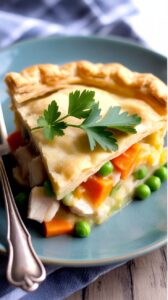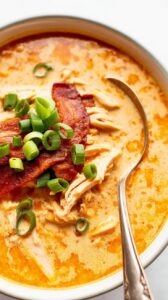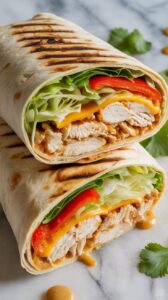This Low Carb Kung Pao Chicken has become one of my favorite go-to meals when I’m craving something bold and comforting but still want to stay low on carbs. It’s got that perfect sweet, salty, and spicy combo, all tossed together in one pan — making it ideal for busy weeknights when I need something fast, flavorful, and satisfying. Think of it as your favorite Chinese takeout, but made right in your own kitchen with ingredients you can trust (and tweak as you like).
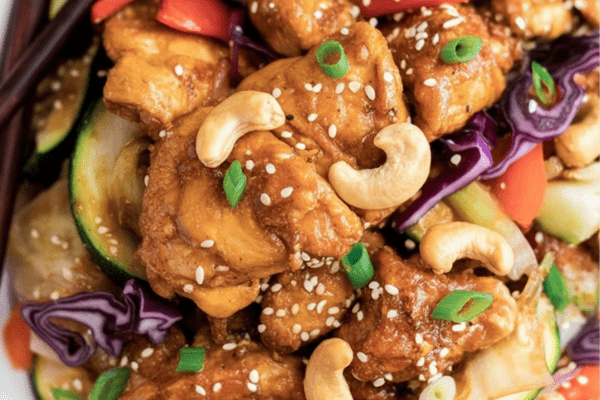
Why You’ll Love This Low Carb Kung Pao Chicken
I’ve always been a fan of dishes that hit multiple flavor notes in one bite — and Kung Pao Chicken is exactly that. This version has all the classic charm of the restaurant favorite, but without the sugar, cornstarch, or deep frying. You still get the richness of umami-packed sauce, the crunch of toasted nuts, and that gentle warmth from dried red chilies.
What makes this one extra special in our house is that it’s totally customizable. My husband prefers his a bit spicier, while I sometimes swap in different veggies depending on what’s in the fridge. It’s a dinner that lets you play around and still turns out delicious every time.
How to Make Low Carb Kung Pao Chicken
Let’s break it down step by step — it’s really simple once you get the hang of it:
1. Make the Sauce
First, mix up the sauce. I usually whisk together:
- Liquid aminos or low-sodium soy sauce
- A splash of fish sauce for depth
- Apple cider vinegar for tang
- Toasted sesame oil for that nutty aroma
- Freshly grated ginger and minced garlic
- A low-carb sweetener like erythritol (I’ve also used monk fruit — works great!)
This sauce is the heart of the dish. It hits all the right notes: salty, sweet, tangy, and just a little funky (thanks, fish sauce!).
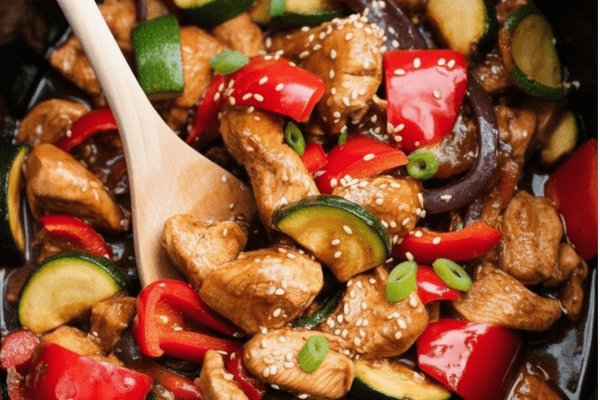
2. Season & Sear the Chicken
I like to use boneless, skinless chicken thighs for juiciness, but breasts work too. Season them with Himalayan salt, cracked black pepper, and a spoonful of that sauce you just made. Let it marinate for at least 10 minutes while you prep the veggies.
Then, in a hot wok or skillet, sear the chicken until lightly browned and just cooked through. Don’t overcrowd the pan — it helps to do this in batches for the best color.
3. Add the Veggies
Here’s where you can get creative. I usually toss in zucchini and red bell peppers for color and crunch. Dried red chilies go in next — and these are key. You don’t have to eat them, but they infuse the whole dish with that signature heat.
If you’re not into spicy food, just toss in fewer chilies, or skip them entirely. No shame in dialing it down.
4. Finish with Sauce & Nuts
Pour in the rest of your sauce and let everything bubble away on high heat for a few minutes. It’ll thicken slightly as it reduces. If you want a thicker glaze, a pinch of xanthan gum does the trick — just sprinkle it in and stir well.
Toss in your toasted cashews or peanuts (I’ve even tried macadamia nuts once when I ran out — not traditional, but so tasty). Finish with a sprinkle of sesame seeds and sliced green onions.
Serve it hot over cauliflower rice or zucchini noodles for a complete low carb meal. Or honestly, eat it straight from the pan like I sometimes do when no one’s watching.
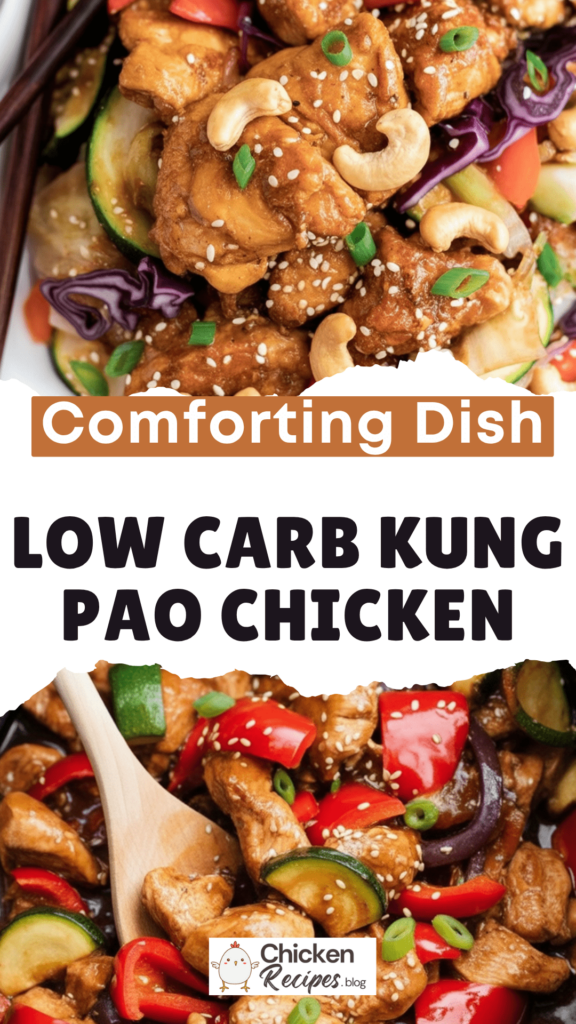
What’s the Difference Between Kung Pao Chicken and General Tso’s Chicken?
This comes up a lot — especially if you love both and are wondering which one to try at home.
General Tso’s Chicken is usually breaded and deep-fried, with a heavier, stickier sauce. It leans more on the sweet side, often without many veggies.
Kung Pao, on the other hand, is lighter and more savory, with a cleaner heat and more texture from the nuts and veggies. It’s traditionally stir-fried, not deep-fried — which also makes it a great choice for low-carb cooking.
What Vegetables Go Well with Kung Pao Chicken?
In my version, I’ve used zucchini and red bell peppers — mostly because they cook quickly and stay a little crisp, which I love. But honestly, use what you’ve got.
Some other favorites:
- Broccoli florets (especially if they’re pre-steamed)
- Snow peas
- Mushrooms
- Cauliflower
- Baby bok choy
Just keep in mind the water content of your veggies and adjust cooking time as needed so nothing turns mushy.
Serving Suggestions
I almost always serve this over cauliflower rice. It’s quick to make (especially if you’re using frozen pre-riced cauliflower), and it soaks up the sauce beautifully. Another great option is spiralized zucchini or even thinly sliced cabbage for something a little different.
For guests who aren’t watching carbs, steamed jasmine rice or fried rice is a perfect base.
If you’re meal prepping, portion it into containers with your base of choice and store it for lunch or dinner during the week.
How to Store Leftovers
This dish stores like a champ. Here’s what I do:
- Fridge: Store in an airtight container for up to 4 days. Reheat in a pan over medium heat with a splash of water or broth to loosen the sauce.
- Freezer: Freeze in portions for up to 2 months. Thaw in the fridge overnight, then reheat as above.
It makes a great lunchbox meal too — just skip the nuts until serving so they stay crunchy.
Frequently Asked Questions
Can I make this nut-free?
Absolutely. Just skip the cashews or peanuts and maybe add a few water chestnuts or toasted seeds (like sunflower) for crunch.
Is it spicy?
That depends on how many dried red chilies you use. I typically go with 4–5 for a medium heat. If you’re sensitive to spice, start with 1 or 2 — or leave them out entirely.
What’s a good substitute for erythritol?
Monk fruit sweetener, stevia blends, or even a little coconut aminos (which is naturally sweet) can work. Just taste and adjust.
Can I add more protein?
Yes — you can mix in shrimp, tofu, or even ground chicken if that’s what you’ve got. Just adjust the cooking time accordingly.
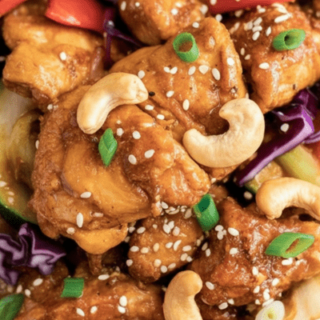
Low Carb Kung Pao Chicken
This Low Carb Kung Pao Chicken has become one of my favorite go-to meals when I'm craving something bold and comforting but still want to stay low on carbs.
Ingredients
For the sauce:
- 3 tablespoons coconut aminos or low sodium soy sauce
- 1 teaspoon fish sauce
- 2 teaspoons sesame oil
- 1 teaspoon apple cider vinegar
- 1/4 - 1/2 teaspoon red pepper chili flakes to taste
- 1/2 teaspoon fresh minced ginger
- 2 cloves garlic minced
- 2-3 tablespoons water or chicken broth
- 1-2 teaspoons monk fruit or erythritol, adjust to desired sweetness level
For the stir-fry:
- 3/4 lb chicken thighs cut into 1 inch pieces
- Himalayan pink salt and black pepper as needed
- 3-4 tablespoon olive oil or avocado oil
- 1 red bell pepper chopped into bite-sized pieces
- 1 medium-large zucchini chopped into halves
- 2 - 3 dried red chili peppers to taste found in Asian supermarkets or the International section of a large chain grocery store (can also substitute with 1-2 teaspoons Sriracha)
- 2/3 cup roasted cashews or roasted peanuts
- 1/4 teaspoon xanthum gum optional for thickening sauce
- Sesame seeds and chopped green onions for garnish (optional)
Instructions
- In a medium bowl, mix all the ingredients for the sauce and set it aside.
- Season the chicken with salt, pepper, and a spoonful of the prepared sauce or marinade.
- Heat oil in a wok or large non-stick skillet over medium-high heat. Add the chicken and cook until it starts to brown and is nearly cooked through, about five to six minutes.
- Add the zucchini, bell peppers, and dried chili peppers if using, and cook until the vegetables are crisp-tender and the chicken is fully cooked.
- Pour in the remaining sauce and add the cashews. Stir everything together and increase the heat to high to let the sauce reduce and thicken. Adjust seasoning with salt, pepper, or extra red pepper flakes as desired. For a thicker sauce, you can mix in a small amount of xanthan gum.
- Remove from heat and serve warm on a platter or over zoodles or cauliflower rice. Garnish with sesame seeds and green onions if you like.
Nutrition Information:
Yield: 4 Serving Size: 1Amount Per Serving: Calories: 588Total Fat: 46gSaturated Fat: 9gTrans Fat: 0gUnsaturated Fat: 36gCholesterol: 111mgSodium: 1223mgCarbohydrates: 21gFiber: 4gSugar: 9gProtein: 28g
Chickenrecipes.blog, occasionally offers nutritional information for recipes contained on this site. This information is provided as a courtesy and is an estimate only. This information comes from online calculators. Although allchickenrecipes.com attempts to provide accurate nutritional information, these figures are only estimates.
If you’re looking for a low carb dinner that doesn’t feel like a compromise, this Kung Pao Chicken delivers every time. It’s fast, flavorful, and full of textures — just the kind of meal I love sharing with friends and family on a weeknight. Give it a go, and don’t be surprised if it becomes part of your regular rotation too.
Try other recipes:
